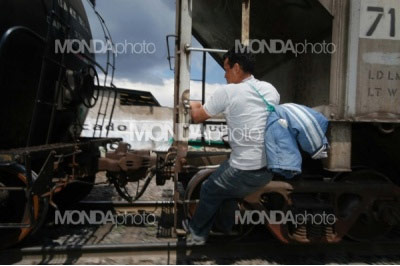TULTITLAN, Mexico — The shanty’s two walls are built with flattened 50-gallon steel drums. A dirty orange tarp serves as the roof, sheltering a group of young men from the scorching summer sun. The floor is dirt. The furniture is a discarded mattress, covered by a sheet of electric-blue bubble wrap whose bubbles have all burst. Hoping for a scrap of food, an old dog with a white eye mills among hungry people.

- Just outside Mexico City, migrants rest on their way to the U.S. (Photo: Alfredo Pelcastre/MondaPhoto)
The shack sits some 6 feet from the closest of four northbound railroad tracks that are the reason the men are here. These rail yards outside Mexico City are a major hub for freight trains connecting the capital with the country’s south and north. As such, they are a stopover for Central American migrants riding trains across Mexico to reach the U.S.
The journey is extremely dangerous and the stories these seven men tell highlight the perils faced by the hundreds of Guatemalans, Hondurans, Salvadorans and others who begin the trip every day. Since they entered Mexico at the southern state of Chiapas a few days ago, the men say they have seen or experienced just about everything: Some have been beaten, forced to pay bribes, robbed by law enforcement officers, ripped off by shopkeepers and bus drivers, cheated by smugglers, ambushed and mugged by gun-toting bandits.
Omar Morales, 31, a Honduran peasant on his way to meet relatives in New Jersey and New York City, says he was held at gunpoint and forced to lie naked on the ground while a woman traveling in his group was raped by a man who also robbed them.
“They rip your clothes until they find what they want,” says Morales, the eldest in this group. “They hit me in the head with a shotgun.”
While the Mexican government demands respect for the human rights of its undocumented countrymen inside the U.S., an uncomfortable double-standard appears to be unfolding within its own borders: Many Central American migrants traversing the country are victims of violence and abuse, according to activists and public officials.
Although outgoing President Vicente Fox’s administration has launched several initiatives to help the migrants, experts say those measures have been inadequate. The issue rarely was mentioned in the campaign leading to today’s presidential elections.
“There is an incongruity between a foreign policy that is very active in the defense of Mexican migrants’ human rights abroad … and an interior policy aimed towards the detention of migrants that stands far from guaranteeing the exercise of human rights,” says Karina Arias, a spokeswoman for Sin Fronteras (Without Borders), a human rights organization in Mexico City.
“There are major problems in terms of violence against (Central American) migrants,” says Daniel Wilkinson, deputy director for the Americas at Human Rights Watch in New York. “It’s a population very vulnerable to extortion, violent crime, sexual exploitation, corruption, because they are people who are trying to avoid authority.”
NUMBERS INCREASING
Although Mexico’s southern border has seen heightened enforcement, the migratory flow keeps rising, officials say. There are no statistics on how many people attempt the trip, but Mexico’s National Institute of Migration provides figures of those detained for lack of documentation: The 240,000-plus detained in 2005 represented a 74 percent increase since 2001.
There are no comprehensive numbers for the cases of abuse either, but an increasing flow means more potential victims.
“Violations (against migrants) are committed all over the national territory,” says Mauricio Farah, the top official for migration issues at the National Commission on Human Rights, an independent federal agency.

- A migrant runs to catch a northbound train leaving the Tultitlan railyard. (Photo: Carlos Aranda/Mondaphoto)
Under the tarp, the travelers talk about a raid they escaped in the southern state of Veracruz two days earlier. As the train they rode was stopping, they say, Migration and police officers surrounded it. They estimate only 20 people out of several hundred got away and made it to Tultitlan. Esteban Perez, 29, a Salvadoran who was in that train, shows the pink flesh of an open wound above his left eye. An officer in the raid, he says with an angry scowl, “tried to hit me in the chest with his gun.”
The men complain of policemen who extort them under the threat of handing them over to Migration officers (only the latter are allowed to detain undocumented migrants.)
“If (the police) detain you, it’s because they want money,” says Honduran Oscar Orlando, 24. The migrants also say bus drivers usually overcharge them knowing they won’t call the police. “One charged me 200 pesos instead of 10 (about $1),” says Wilmer Pereira, 21, another Honduran, whose thick eyebrows spend most of the time in a frown.
Morales, the peasant, says some of the coyotes who carry migrants in vans promise to circumvent Migration checkpoints. “After you give them the money,” he says, “they signal with their headlights and the checkpoint stops them.”
‘ADMINISTERING THE FLOW’
Last April, a young Mexican man from Tultitlan was shot to death some 300 yards from this spot, when a Migration officer mistook him for an undocumented immigrant.
Residents rioted and destroyed two patrol pickup trucks. “We don’t let (migration officers) in here any more,” says Janette Velazco Sanchez, 17, a friend of the dead man who sells food to migrants from a small wooden shack by the tracks.
The Fox administration has taken measures to improve the treatment of migrants, says Hermenegildo Castro, a National Institute of Migration spokesman. (Requests for interviews with senior Migration and Foreign Relations officials were denied.)
Castro mentions the construction of better detention stations for undocumented migrants, 400 new INM officers hired in the past two years, 185 dismissed since 2001 for human rights violations or “a loss of confidence in them,” and faster deportations after detention. Mexico also has launched regularization programs for undocumented foreigners who have been in the country two years and are married to a citizen or employed, he says.
Castro acknowledges, however, that stopping the migration is not feasible. “It’s more a question of administering the flow,” he says.
Experts say the government’s measures were clearly not enough.
“The intention of respecting human rights is in the official discourse,” says Professor Manuel Angel Castillo of the Colegio de Mexico. “The problem is putting that in practice.” But Castillo says the cause for the abuses “is not that there is intention on the part of the state. There is an inability to intervene on the part of the state.”
Professor Hugo Angeles Cruz of the College of the South Border in Tapachula says Fox did pay attention to the issue, but “violations are in the same status they were at the start of (his) term.”
PROMISES OF REFORM
The migrants’ plight was not a campaign issue. But foreign policy representatives of leading presidential candidates vow to address the problem.
Arturo Sarukhan, of the governing National Action Party, says the situation is first a human rights matter, but also a strategic need for Mexico. “It’s a gap of enormous vulnerability, in political terms and in terms of image,” he says. Talia Vazquez Alatorre, of the leftist Democratic Revolution Party, says, “American (immigration) legislation is more up-to-date than the Mexican one. How sad.”
Most of those interviewed agree the General Population Act, which has governed immigration to Mexico since 1974, needs a comprehensive update. The law — it makes undocumented entry a crime punishable by up to two years in prison — is harsher than bills being discussed in Washington.
In Tultitlan, the afternoon heat is punctuated by the buzz of flies. A red engine chugs back and forth as cars are hitched to it. It’s the 3 o’clock to San Luis Potosi, some 250 miles north.
The men approach the now still train and stand or squat close to it in silent tension, like sprinters waiting for the gun. Finally, the convoy jerks forward and starts to speed up. Salvadoran Byron Alas, 29, runs three, four steps and jumps and clings from a ladder. The others quickly follow. Soon they all pick spots at the ends of two cars that look like Dumpsters on wheels.
Morales climbs on top of one car. He is making the trip because he can’t support his wife and three kids raising corn and beans. “One of them says she wants to get a B.A.,” he has said earlier, adding a proud smile.
“You know there are dangers: robbers, accidents on the train, the police. Anyway, you have to take the risk, to see if you can earn something.”
 Every-Night Fever at the Milonga (2007)
Every-Night Fever at the Milonga (2007)  Migrants Suffer in Mexico (2006)
Migrants Suffer in Mexico (2006)  Leaving Wall Street (2006)
Leaving Wall Street (2006)  Torn Up Over Being Torn Down (2004)
Torn Up Over Being Torn Down (2004) 


